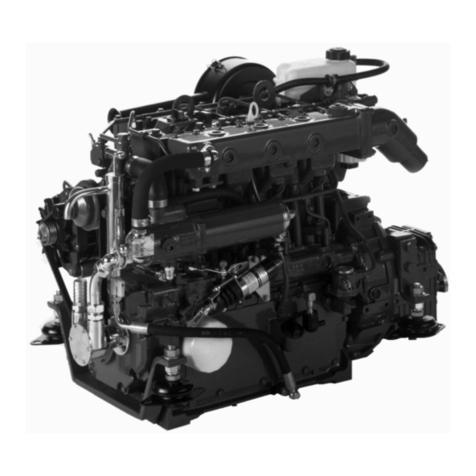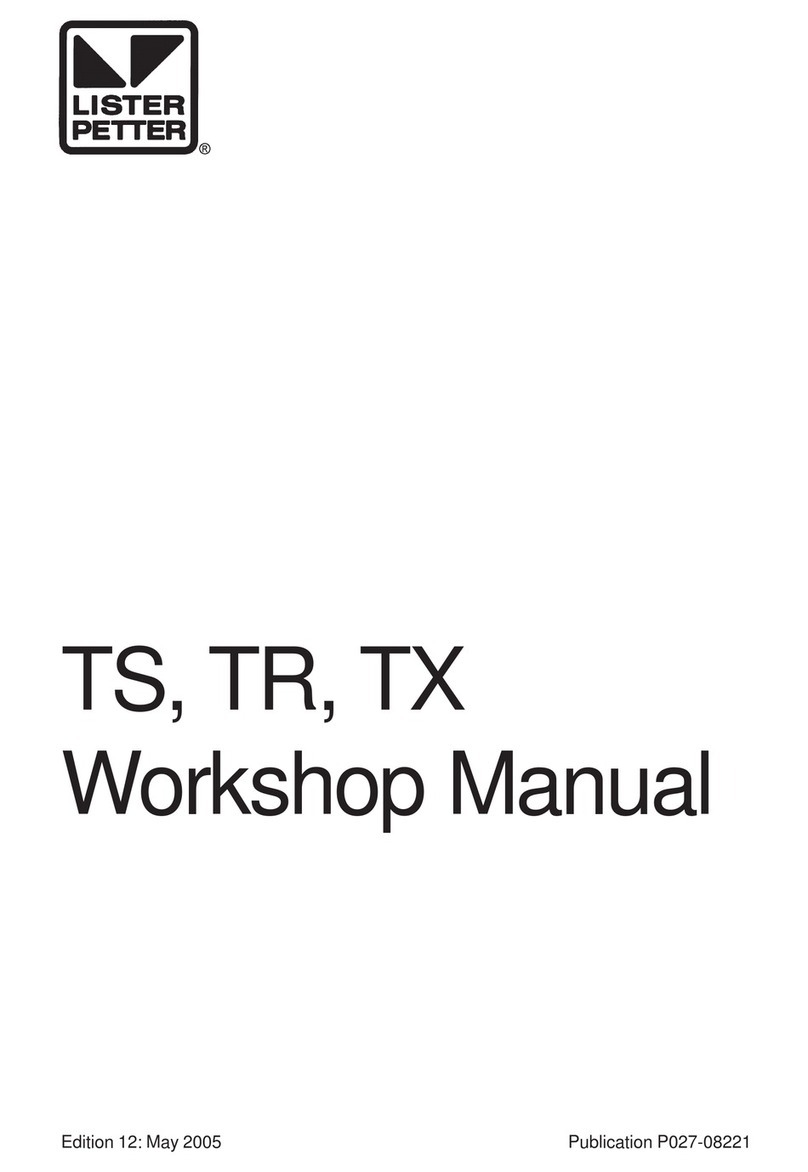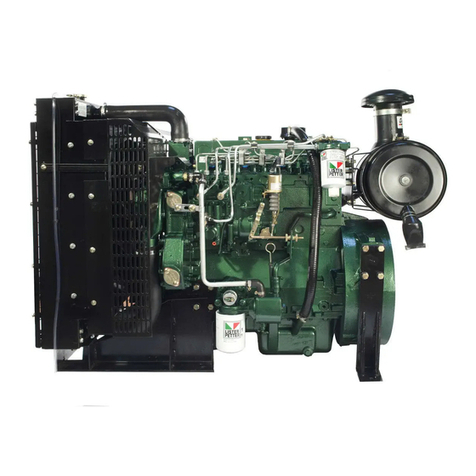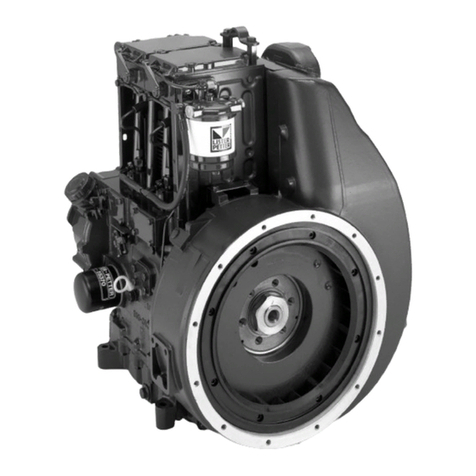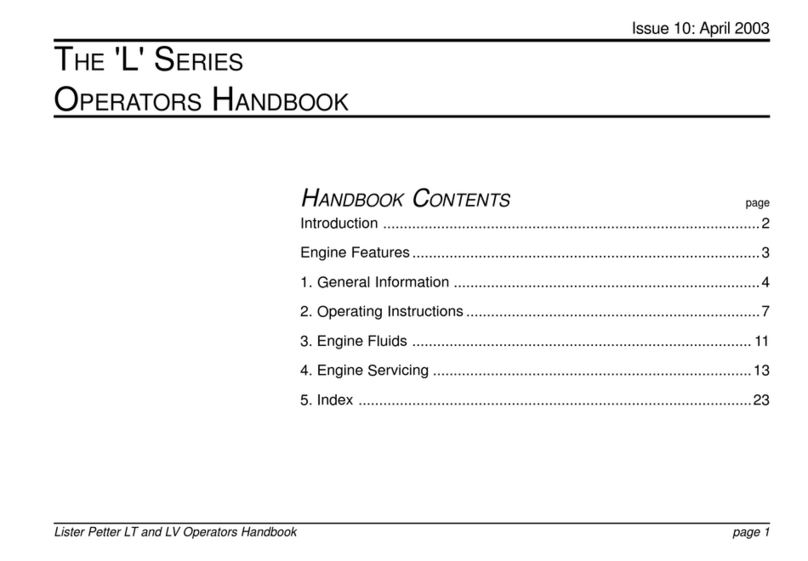
TS, TR, TX engines workshop manual 10
1.4 Engine Identication
Nomenclature
TSandTR - one,twoandthree cylinder,directinjection, naturally
aspirated ywheel fan air cooled diesel engines.
TX - two and three cylinder, direct injection, naturally aspirated,
axial fan air cooled diesel engines.
Engine Serial Number
The engine serial number is stamped on a plate attached to
the engine.
It is necessary to identify the type and build of each engine to
enable the correct maintenance procedures, as described later
in this publication, to be carried out.
An example number is shown below.
03 001234 TS3 A 01
03........................................Year code (03 = 2003)
001234............................... Unique engine number
TS3 ...................................................Engine series
A ......................................... Anti clockwise rotation
01...................................................... Build number
1.5 Battery Details
WARNING
Battery posts, terminals and related accessories contain
lead and lead compounds, chemicals known to the State
of California to cause cancer and reproductive harm.
Wash hands after handling.
WARNING
Sulphuric acid in battery electrolyte is poisonous, is
strong enough to burn skin, eat holes in clothing and
cause blindness if splashed into the eyes.
Battery Polarity
All electric start engines have a 12 or 24 Volt negative earth
system and a 12 Volt ywheel mounted charging system is
available for some TS and TR engine builds.
Recommended Battery Type
HeavyDutyBatteriestoBS3911:982orIEC95-1arerecommended
for all engine applications.
For temperatures below -18°C (0°F), high discharge, low
resistance Arctic or Alkaline batteries must be used.
Lister Petter Power Systems recommend that a battery should
provide a minimum cranking period of 60 seconds from a
70% charged 12 volt battery, with a minimum voltage at the
end of the cranking period of 8.4 volts (16.8 volts on a 24 volt
system).
Preparing a Battery for Use
The following procedure should be used to prepare a battery
with factory sealed charge.
1.Where necessary remove the ash seal in each vent plug hole.
2. Fill with battery grade sulphuric acid of specic gravity 1.260
(1.200 for tropical climates - see Note).The temperature of this
acid should not be above 30°C (90°F) before lling.The correct
level is 6mm (0.25in) above the separator guards.
3. Stand the lled battery for one hour and adjust the acid to
the correct level by adding more acid where necessary.
4. Charge the battery at 6-12 amps for a minimum period of
4 hours.
5. At the end of this charge period the specic gravity of the acid
in any cell should not be less than 1.260 (1.200 for tropical
climates).
If the specic gravity readings are uneven or the specic
gravity low, continue charging until two consecutive half
hourly readings of specic gravity and charge voltage are
approximately the same.
Discontinue charging and allow the battery to cool if the
temperature rises above 40°C (110°F).
Note:
Tropical climates apply to those countries or areas where the average temperature of
any month of the year exceeds 27°C (80°F).
Connecting Batteries
It is most important to ensure that the starter battery, or
batteries, are properly connected and all connections are
tight.
T SERIES ENGINES WORKSHOP MANUAL
10
1.4 ENGINE IDENTIFICATION
Nomenclature
TS and TR - one, two and three cylinder, direct
injection, naturally aspirated flywheel fan air cooled
diesel engines.
TX - two and three cylinder, direct injection, naturally
aspirated, axial fan air cooled diesel engines.
Engine Serial Number
The engine serial number is stamped on a plate
attached to the engine.
It is necessary to identify the type and build of
each engine to enable the correct maintenance
procedures, as described later in this publication,
to be carried out.
An example number is shown below.
03 001234 TS3 A 01
03........................................ Year code (03 = 2003)
001234............................... Unique engine number
TS3...................................................Engine series
A ......................................... Anti clockwise rotation
01...................................................... Build number
1.5 BATTERY DETAILS
WARNING
Battery posts, terminals and related accessories
contain lead and lead compounds, chemicals
known to the State of California to cause cancer
and reproductive harm. Wash hands after
handling.
WARNING
Sulphuric acid in battery electrolyte is poisonous,
is strong enough to burn skin, eat holes in
clothing and cause blindness if splashed into
the eyes.
Battery Polarity
All electric start engines have a 12 or 24 Volt
negative earth system and a 12 Volt flywheel
mounted charging system is available for some TS
and TR engine builds.
Recommended Battery Type
Heavy Duty Batteries to BS3911:982 or IEC95-1 are
recommended for all engine applications.
For temperatures below -18°C (0°F), high discharge,
low resistance Arctic or Alkaline batteries must be
used.
Lister Petter Power Systems recommend that a
battery should provide a minimum cranking period
of 60 seconds from a 70% charged 12 volt battery,
with a minimum voltage at the end of the cranking
period of 8.4 volts (16.8 volts on a 24 volt system).
Preparing a Battery for Use
The following procedure should be used to prepare a
battery with factory sealed charge.
1.Where necessary remove the flash seal in each
vent plug hole.
2.Fill with battery grade sulphuric acid of specific
gravity 1.260 (1.200 for tropical climates - see
Note). The temperature of this acid should not be
above 30°C (90°F) before filling. The correct level
is 6mm (0.25in) above the separator guards.
3.Stand the filled battery for one hour and adjust
the acid to the correct level by adding more acid
where necessary.
4.Charge the battery at 6-12 amps for a minimum
period of 4 hours.
5.At the end of this charge period the specific gravity
of the acid in any cell should not be less than 1.260
(1.200 for tropical climates).
If the specific gravity readings are uneven or the
specific gravity low, continue charging until two
consecutive half hourly readings of specific gravity
and charge voltage are approximately the same.
Discontinue charging and allow the battery to cool
if the temperature rises above 40°C (110°F).
Note:
Tropical climates apply to those countries or
areas where the average temperature of any
month of the year exceeds 27°C (80°F).
Connecting Batteries
It is most important to ensure that the starter
battery, or batteries, are properly connected and all
connections are tight.
Figure 1.5.1 Battery Connections
A - 12 volt system using four 6 volt batteries connected in
series-parallel; B - 12 volt system using two 6 volt batteries
connected in series.
Connecting a Slave Battery
A slave, or booster battery can be connected in
parallel with the existing battery to aid starting in
cold weather conditions.
Figure 1.5.1 Battery Connections
A - 12 volt system using four 6 volt batteries connected in series-parallel;
B - 12 volt system using two 6 volt batteries connected in series.
Connecting a Slave Battery
A slave, or booster battery can be connected in parallel with the
existing battery to aid starting in cold weather conditions.
WARNING
Heavy duty jumper leads must always be used and no
attempt must be made to use any others.
WARNING
Do not allow the jumper lead free ends to directly, or
indirectly touch the engine at any time.

